Diseases and Their Classification | Science & Technology for UPSC CSE PDF Download
Health is described as the state of complete physical, mental, and social well being. Being healthy is far more than just being free from diseases. The disease is a condition of disturbed functioning of the body caused by infection, defective diet, heredity, environment, or deprived condition of the brain. Health is a state of complete physical, mental, and social well being.
The disease may be a response to
- Environmental factors (as malnutrition, industrial hazards, or climate)
- Specific infective agents (as worms, protozoans, fungi, etc)
- Inherent defects of the organism (as genetic anomalies.)
- Combination of these factors
Causes of Diseases/Disease Agents
A disease agent is an organism, substance, or force which causes disease due to its excessive presence, deficiency, or absence.
- Pathogens/Biological Agents: They are biological entities which cause infectious diseases, e.g., viruses (mumps, chickenpox, smallpox), mycoplasma (e.g, bronchitis, acute leukemia), chlamydia (e.g, trachoma), bacteria (e.g. cholera, tetanus), fungi (ringworm, thrush, moniliasis, pulmonary aspergillosis), protozoa (e.g. giardiasis, sleeping sickness), helminths (e.g., filariasis, ascariasis, taeniasis), other organisms (e.g., scabies).
- Nutrient Agents: Deficiency of vitamins (e.g., beriberi, scurvy, night blindness), minerals (e.g., anaemmia, rickets), carbohydrates, fat, and proteins (e.g., kwashiorkar, marasmus), or excess of food (e.g., obesity).
- Chemical Agents: Endogenous Agents– Excess presence of uric acid, reduced secretion of ADH (diabetes insipidus) or insulin (diabetes mellitus). Exogenous Agents- Pollutants (e.g., pneumoconiosis), allergens (allergy).
- Physical Agents: Heat (e.g., stroke), cold (frostbite), radiations, sound (impaired hearing), humidity, etc.
- Mechanical Agents: Fractures, sprains, dislocation, injury, chronic friction.
- Genetic Agents: Excess or deficiency of chromosomes, mutations, harmful alleles, e.g, colour blindness, albinism, haemophilia, Turner’s syndrome.
Types of Disease
Hereditary Diseases
Hereditary diseases are disorders or diseases that are inherited genetically. They are also known as genetic disorders or inherited diseases and may be passed on within the family if there is a mutant gene present.
They are Further Divided into –
Autosomal Dominant
- Only one mutated copy of the gene will be necessary for a person to be affected by an autosomal dominant disorder. Each affected person usually has one affected parent. The chance a child will inherit the mutated gene is 50%.
Huntington’s Disease (HD)
- Also known as Huntington’s chorea is an inherited disorder that results in the death of brain cells.
Down Syndrome
- Down syndrome is also known as Trisomy 21 and it is caused by the inheritance of an extra chromosome 21. This condition causes a delay in the mental and physical development of a child. This genetic disorder is rare and may be detected before a child is born.
Hereditary Spherocytosis
- This genetic disorder is featured by abnormal red blood cells that may lead to hemolytic anemia and enlargement of the spleen (splenomegaly).
 Spleen
Spleen
Note– Other autosomal dominant diseases include Jackson Weiss Syndrome and galactosemia.
Autosomal Recessive Diseases
- These genetic disorders are passed when both of the parents carry a defective gene. The following are some of them.
Tay – Sachs Disease
- Tay – Sachs disease is a disorder of the nervous system that impairs motor skills. The affected child experiences symptoms such as delayed growth, dementia, irritability, and even paralysis.
Polycystic Kidney Disease
- This genetic disorder is very rare and it is featured by the number of cysts formed on the kidneys can lead to kidney failure.
Usher Syndrome
- Usher syndrome is categorized into three major types as types I, II, and III.
- Type I is characterized by hearing loss or deafness that may be present from birth.
- Type II means that the affected person is born deaf but may lose vision during adolescence.
- Finally, type III manifests with hearing and vision loss that occurs when a person is 10 years old.
Hereditary Fructose Intolerance
- This hereditary disease causes the absence of enzyme aldolase B in a person, which is required for metabolizing fructose. Symptoms of hereditary fructose intolerance include severe abdominal pain, vomiting, and aversion to sweet foods.
Sickle Cell Anemia
- It is a group of blood disorders typically inherited from a person’s parents. It results in an abnormality in the oxygen-carrying protein hemoglobin (hemoglobin S) found in red blood cells. Note– Other autosomal recessive diseases include: albinism, cystic fibrosis and phenylketonuria.
Sex-Linked or Gender linked Diseases
- Gender-linked disorders occur due to errors in the X or Y chromosome. They include the following.
Color Blindness
- This condition causes eye nerve damage and the affected person can’t differentiate between colors.
Hemophilia
- The word hemophilia derives from two Greek words: haima, meaning blood, and philia, meaning affection. Hemophilia is a hereditary condition. This means that it is passed on from mother to child at the time of conception.
- This disorder causes the inability of the blood to coagulate. This condition affects only males.
Muscular Dystrophy
- It is a muscle disorder that causes weakness of the skeletal muscles, degeneration of the muscles, and defective muscle proteins.
Polygenic Disorders
- These genetic disorders are caused by multiple genes and may not be completely inherited but represent a risk factor for certain diseases such as diabetes, heart disease, obesity, cancer, and autoimmune disorders.
Bacterial Diseases
Bacterial diseases include any type of illness caused by bacteria. Bacteria are a type of microorganism, which are tiny forms of life that can only be seen with a microscope. Other types of microorganisms include viruses, some fungi, and some parasites.
Examples are
- Diphtheria
- Anthrax
- Pneumonia
- Leprosy
- Tuberculosis
- Plague– Plague is caused by the bacteria Yersinia pestis, a zoonotic bacterium usually found in small mammals and their fleas.
- Meningitis– an infection of the tissues that cover and protect the brain and spinal cord — can be caused by viruses, bacteria, or fungi.
- Cholera
- Tetanus
- Typhoid fever
- Lyme disease
- Whooping cough
- Gonorrhea – It is a sexually transmitted disease. It is caused by the gonococcus, Neisseria gonorrhoeae—a bacterium.
- Syphilis – a systemic disease that is caused by the spirochete bacterium, Treponema pallidum. Syphilis is usually a sexually transmitted disease, but it is occasionally acquired by direct nonsexual contact with an infected person, and it can also be acquired by an unborn fetus through infection in the mother.
Viral Diseases
A viral disease is any illness or health condition caused by a virus.
Virus – A virus is a small infectious agent that replicates only inside the living cells of other organisms. They’re made up of a piece of genetic material, such as DNA or RNA, that’s enclosed in a coat of protein.
Viruses invade cells in your body and use components of those cells to help them multiply. This process often damages or destroys infected cells.
Examples are
- Influenza-Flu by influenza virus
- Common Cold- Rhinovirus
- Hepatitis A– Liver
- Norovirus-Gastro-intestinal illness
- Rotavirus– Diarrhea
- Human Papilloma Virus (HPV)
- Hepatitis B– Inflammation in the liver
- HIV
- Measles
- Rabies
- Smallpox
- Polio
- Rubella
- Chickenpox
- Japanese Encephalitis
- Zika Viral Fever
- Yellow Fever
- MERS-CoV (Middle East respiratory syndrome)
- SARS – Severe Acute Respiratory Syndrome
Protozoan Diseases
Protozoan infections are parasitic diseases caused by organisms formerly classified in the Kingdom Protozoa.
Protozoal disease, a disease caused by protozoans. These organisms may remain in the human host for their entire life cycle, but many carry out part of their reproductive cycle in insects or other hosts. For example, mosquitoes are vectors of plasmodium, the cause of malaria.
They are usually contracted by either an insect vector or by contact with an infected substance or surface and include organisms that are now classified in the supergroups Excavata, Amoebozoa, SAR, and Archaeplastida.
Examples –
- Malaria
- Amoebiasis
- Trichomoniasis
- African Sleeping sickness or Trypanosomiasis
- Leishmaniasis or Kala-azar
- Giardiasis
- Balantidiasis
- Toxoplasmosis
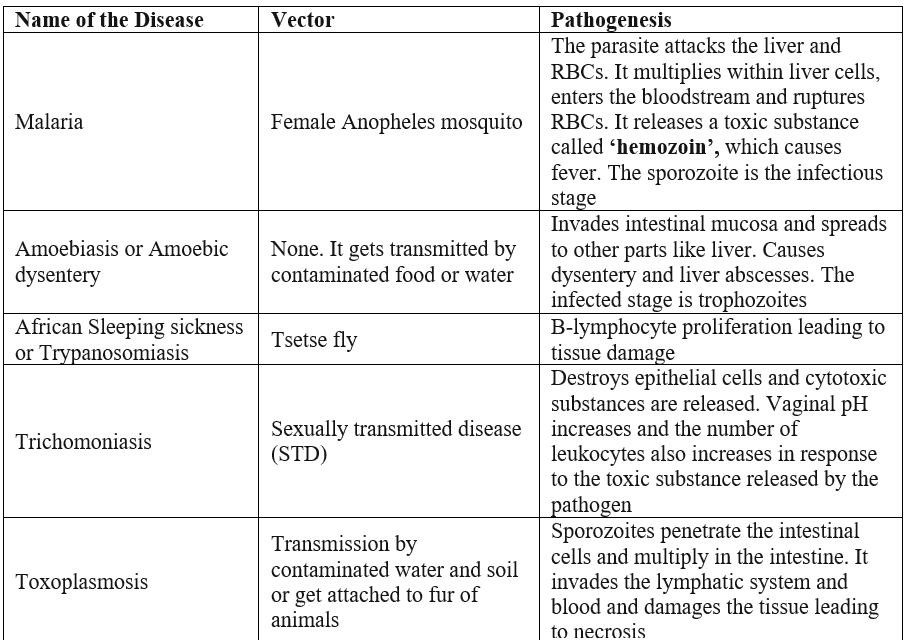
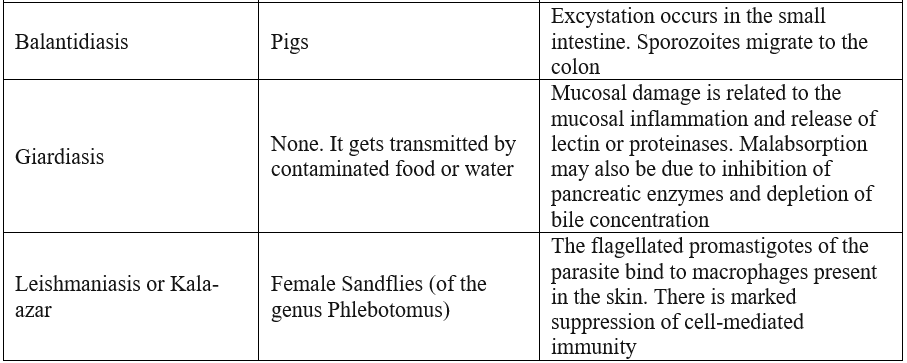
Zoonotic Diseases
Zoonotic Diseases are diseases that can be passed between animals and humans. Viruses, bacteria, parasites, and fungi can cause zoonotic diseases.
Examples –
- Chikungunya
- Malaria
- Yellow Fever
- Zika Virus Disease
- Dengue Fever
- Ebola
- Hepatitis E
- Rabies
- Japanese Encephalitis
- Filariasis
- Lyme disease
- Babesiosis
- Ehrlichiosis
- Ringworm
- Swine flu, also known as the H1N1 virus – caused by type A influenza virus.
- West Nile virus – causes a viral infection that is typically spread by mosquitoes and can cause neurological disease as well as death.
Neglected tropical diseases
Neglected tropical diseases (NTDs) are a diverse group of tropical infections that are especially common in low-income populations in developing regions of Africa, Asia, and the Americas. They are caused by a variety of pathogens such as viruses, bacteria, protozoa and helminths.
Examples –
- Buruli Ulcer
- Rabies
- Dengue
- Chikungunya
- Leprosy (Hansen’s disease)
- Lymphatic Filariasis
- Yaws
- Trachoma
- Schistosomiasis
Diabetes
Diabetes is a chronic disease that occurs either when the pancreas does not produce enough insulin or when the body cannot effectively use the insulin it produces.
Insulin is a hormone that regulates blood sugar.
Hyperglycaemia, or raised blood sugar, is a common effect of uncontrolled diabetes and over time leads to serious damage to many of the body’s systems, especially the nerves and blood vessels.
Note- Diabetes mellitus is a chronic disease caused by inherited and/or acquired deficiency in the production of insulin by the pancreas, or by the ineffectiveness of the insulin produced. Such a deficiency results in increased concentrations of glucose in the blood, which in turn damage many of the body’s systems, in particular the blood vessels and nerves.
Type 1 diabetes
- Type 1 diabetes (previously known as insulin-dependent, juvenile, or childhood-onset) is characterized by deficient insulin production and requires daily administration of insulin. The cause of type 1 diabetes is not known and it is not preventable with current knowledge.
- Symptoms include excessive excretion of urine (polyuria), thirst (polydipsia), constant hunger, weight loss, vision changes, and fatigue. These symptoms may occur suddenly.
Type 2 diabetes
- Type 2 diabetes (formerly called non-insulin-dependent, or adult-onset) results from the body’s ineffective use of insulin. Type 2 diabetes comprises the majority of people with diabetes around the world and is largely the result of excess body weight and physical inactivity.
- Symptoms may be similar to those of type 1 diabetes but are often less marked. As a result, the disease may be diagnosed several years after onset, once complications have already arisen.
National Diabetes and Diabetic Retinopathy Survey
The survey conducted during 2015-2019 by Rajendra Prasad Centre for Ophthalmic Sciences, All India Institute of Medical Sciences, New Delhi.
- The prevalence of diabetes in India has been recorded at 11.8% in the last four years with almost the same percentage of men and women suffering from the disease.
- The highest prevalence of diabetes (13.2%) was observed in the 70-79 years’ age group. Males showed a prevalence of diabetes (12%) compared to females (11.7%).
- The prevalence of any form of diabetic retinopathy (DR) in the diabetic population aged up to 50 years was found to be 16.9%.
- Prevalence of blindness among diabetics was 2.1% and visual impairment was 13.7%.
- Diabetes and diabetic retinopathy have been emerging as a significant noncommunicable disease leading to ocular morbidity (blindness).
- It is estimated that diabetic retinopathy was responsible for 1.06% of blindness and 1.16% of visual impairment globally in 2015.
- Scientists have recently demonstrated the role of a protein secretagogin (SCGN) in increasing insulin action in obesity-induced diabetes.
- SCGN is now established as a functional insulin-binding protein with therapeutic potential against diabetes.
- SCGN binds to insulin and protects it from various stresses, increases its stability, and adds to its action.
- SCGN is found in lower quantities in the brains of Alzheimer’s patients.
West Nile Virus
- West Nile Virus (WNV) can cause neurological disease and death in people. WNV is commonly found in Africa, Europe, the Middle East, North America, and West Asia.
- WNV is maintained in nature in a cycle involving transmission between birds and mosquitoes. Humans, horses, and other mammals can be infected.
- West Nile Virus (WNV) is a member of the flavivirus genus and belongs to the Japanese encephalitis antigenic complex of the family Flaviviridae. Birds are the natural hosts of the West Nile virus.
Leishmaniasis
- Historically known as “Aleppo boil,” this parasitic infection has recently, as the name suggests, become a problem among Syrian refugees.
- Producing disfiguring skin ulcerations, and occasionally spreading to internal organs with fatal consequences, the increase of cases turning up in Europe among migrants has made it the subject of considerable media interest.
- Leishmaniasis is spread by the bite of the sandfly, however, which means it has a northern limit to its range.
Tuberculosis (TB)
- Tuberculosis (TB) is caused by bacteria (Mycobacterium tuberculosis) that most often affect the lungs. Tuberculosis is curable and preventable.
- TB is spread from person to person through the air. When people with lung TB cough, sneeze, or spit, they propel the TB germs into the air. A person needs to inhale only a few of these germs to become infected.
- People living with HIV are 20 to 30 times more likely to develop active TB disease than people without HIV.
Multidrug-resistant tuberculosis (MDR-TB) is a form of TB caused by bacteria that do not respond to isoniazid and rifampicin, the two most powerful, first-line anti-TB drugs.
MDR-TB is treatable and curable by using second-line drugs. However, second-line treatment options are limited and require extensive chemotherapy (up to 2 years of treatment) with medicines that are expensive and toxic.
- Bedaquiline is used in combination with other TB drugs to treat pulmonary TB in adults when they have multi-drug-resistant TB (MDR-TB).
- Delamanid is given to adults with TB that is affecting the lungs, and which is multidrug-resistant.
DOTS is currently the WHO-recommended strategy for TB control. DOTS must be used throughout the entire course of therapy for the best cure rates. The core intervention involves a health worker who observes the patient when s/he is swallowing each dose of anti-TB medication. DOTS also involves the regular collection of sputum specimens until two consecutive samples test negative for AFB.
- NIKSHAY– A web-based solution for monitoring of TB patients to monitor the Revised National Tuberculosis Programme (RNTCP) effectively, a web-enabled and case-based monitoring application called NIKSHAY has been developed by National Informatics Centre (NIC).
Global Tuberculosis Report
- World Health Organization released its annual Global Tuberculosis Report for 2019. WHO has published a global TB report every year since 1997.
- The main aim of the report is to provide a comprehensive and up-to-date assessment of the TB epidemic, and of progress in the prevention, diagnosis, and treatment of the disease, at global, regional, and country levels.
Key Findings of 2019 Report
- The END TB strategy by the WHO aimed to reduce TB by 20 percent from 2015-18. However, between 2015 and 2018, only 6.3 percent of TB cases showed a cumulative decline.
- In 2019, the low- and middle-income countries, accounting for 97 percent of reported TB cases, received global funding of $6.8 billion. This amount is $3.3 billion less than the $10.1 billion estimated to be required in the Stop TB Partnership’s Global Plan to End TB 2018–2022.
- Of the 10 million new cases worldwide, 3 million cases went unreported to the authorities. In India, 1.99 million of the 2.69 million in India were reported.
- 26.9 percent of the global TB burden in 2018 was from India.
- Key five risk factors attributable to new cases of TB: undernourishment, smoking (especially among men), alcohol abuse, HIV infection, and diabetes.
Global Fund for AIDS, TB, and Malaria
- The Global Fund to Fight AIDS, Tuberculosis, and Malaria (the Global Fund or GFATM) is a private-public partnership aimed at leveraging and providing funding for the three focal diseases outlined in its title.
- Set up in 2002, the fund was part of a new ‘breed’ of players in the field of global health, combining skills from bilateral and multilateral agencies with the private sector and civil society.
- Highly innovative in its structure and funding model, the Global Fund’s secretariat in Geneva provides grants directly to one or more organizations – not just governments – in recipient countries.
- India has recently announced a contribution of $22 million to the Global Fund for AIDS, TB, and Malaria (GFTAM) for the 6th replenishment cycle (2020-22).
- India shares a sustained partnership with the Global Fund since 2002 both as a recipient and as a donor.
- In the current funding cycle (2018-21), the Global Fund has allocated US$ 500 million to India. As a donor, India has contributed US$ 46.5 million so far till 2019 including US$ 20 million for the 5th Replenishment.
Leprosy
- Leprosy, also known as Hansen’s disease, is a chronic infectious disease caused by Mycobacterium leprae.
- The disease mainly affects the skin, the peripheral nerves, mucosal surfaces of the upper respiratory tract, and the eyes.
- Leprosy is known to occur at all ages ranging from early infancy to very old age. Leprosy is curable and early treatment averts most disabilities.
- Leprosy is curable with a combination of drugs known as multidrug therapy (MDT), as the treatment of leprosy with only one antileprosy drug (monotherapy) will result in the development of drug resistance to that drug.
- The combination of drugs used in the MDT depends on the classification of the disease. Rifampicin, the most important antileprosy medicine, is included in the treatment of both types of leprosy.
- For the treatment of patients with multibacillary leprosy, WHO recommends a combination of rifampicin, clofazimine, and dapsone; for patients with paucibacillary leprosy, MDT uses a combination of rifampicin and dapsone.
 |
Download the notes
Diseases and Their Classification
|
Download as PDF |
Decoding Blood group Concepts
Blood is a special connective tissue consisting of a fluid matrix, plasma, and formed elements (Erythrocytes, leucocytes, and platelets).
Erythrocytes or red blood cells (RBC) are the most abundant of all the cells in the blood. A healthy adult man has, on average, 5 million to 5.5 million RBCs mm-3 of blood. RBCs are formed in the red bone marrow in adults. RBCs are devoid of the nucleus in most mammals and are biconcave in shape. They have a red coloured, iron-containing complex protein called hemoglobin, hence the colour and name of these cells.
Leucocytes are also known as white blood cells (WBC) as they are colorless due to the lack of hemoglobin. They are nucleated and are relatively lesser in number which averages 6000- 8000 mm-3 of blood.
Leucocytes are generally short-lived. We have two main categories of WBCs – granulocytes and agranulocytes. Neutrophils, eosinophils, and basophils are different types of granulocytes, while lymphocytes and monocytes are agranulocytes. The main function of platelets is to contribute to hemostasis: the process of stopping bleeding at the site of interrupted endothelium. They gather at the site and unless the interruption is physically too large, they plug the hole.
Blood
- Blood accounts for 7% of body weight.
- An average adult has a blood volume of roughly 5 litres.
- Blood cell- RBC-45%, Plasma- 54.3% and WBC-0.7%
Note– Plasma, which is 92 percent water, constitutes 55 percent of blood volume. Plasma contains albumin (the chief protein constituent), fibrinogen (responsible, in part, for the clotting of blood), and globulins (including antibodies).
Antigens
- Antigens also called Immunogens, any substance that stimulates the immune system to produce antibodies.
- Antigens can be bacteria, viruses, or fungi that cause infection and disease.
- Antigens are usually lipids, However, they can also be proteins, carbohydrates, and nucleic acids.
- They can also be substances, called allergens that bring on an allergic reaction.
- Common allergens include dust, pollen, animal dander, bee stings, or certain foods.
- Blood transfusions containing antigens incompatible with those in the body’s own blood will stimulate the production of antibodies, which can cause serious, potentially life-threatening reactions.
- Antigens have origins outside the body
Antibodies
- Antibodies, also called immunoglobulins, are proteins manufactured by the body that help fight against foreign substances called antigens.
- When an antigen enters the body, it stimulates the immune system to produce antibodies.
- The immune system is the body’s natural defense system.
- The antibodies attach, or bind themselves to the antigen and inactivate it.
- Antibodies always originate within the body
ABO Blood Group
There are four principal types: A, B, AB, and O. There are two antigens and two antibodies that are mostly responsible for the ABO types. The specific combination of these four components determines an individual’s type in most cases. The table below shows the possible permutations of antigens and antibodies with the corresponding ABO type (“yes” indicates the presence of a component and “no” indicates its absence in the blood of an individual).
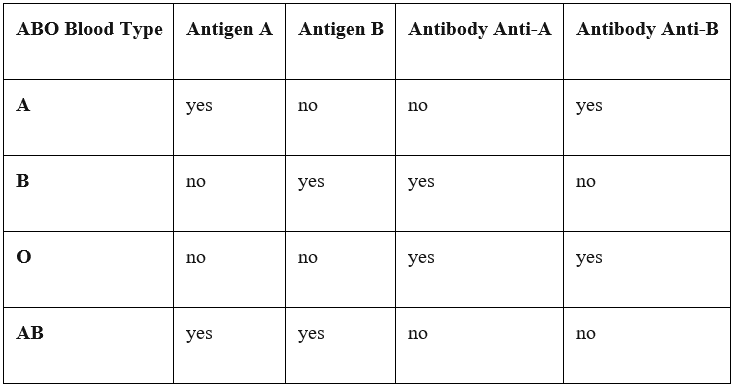
 Blood Group
Blood Group
For example, people with type A blood will have the A antigen on the surface of their red cells (as shown in the table below). As a result, anti-A antibodies will not be produced by them because they would cause the destruction of their own blood.
However, if B type blood is injected into their systems, anti-B antibodies in their plasma will recognize it as alien and burst or agglutinate the introduced red cells in order to cleanse the blood of alien protein.
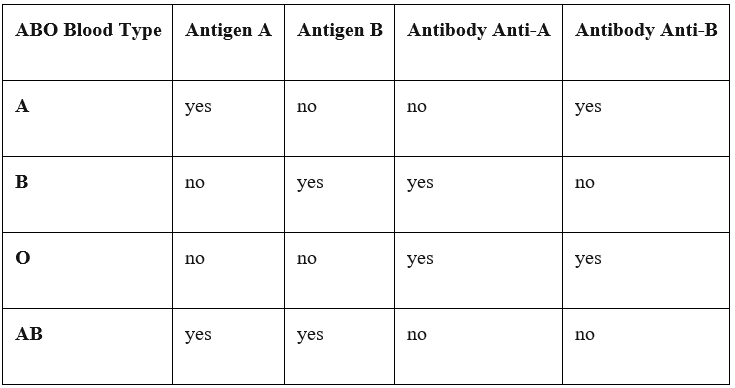
Individuals with type O blood do not produce ABO antigens.
- Therefore, their blood normally will not be rejected when it is given to others with different ABO types.
- As a result, type O people are universal donors for transfusions, but they can receive only type O blood themselves.
Those who have type AB blood do not make any ABO antibodies.
- Their blood does not discriminate against any other ABO type.
- Consequently, they are universal receivers for transfusions, but their blood will be agglutinated when given to people with every other type because they produce both kinds of antigens.
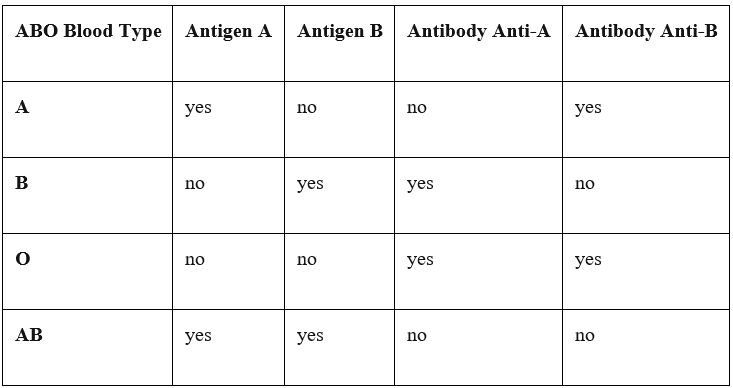
- It is easy and inexpensive to determine an individual’s ABO type from a few drops of blood. A serum containing anti-A antibodies is mixed with some of the blood. Another serum with anti-B antibodies is mixed with the remaining sample.
- Whether or not agglutination occurs in either sample indicates the ABO type.
- It is a simple process of elimination of the possibilities. For instance, if an individual’s blood sample is agglutinated by the anti-A antibody, but not the anti-B antibody, it means that the A antigen is present but not the B antigen. Therefore, the blood type is A.
 Blood Groups
Blood Groups
Rh Blood Group System
In addition to the ABO blood grouping system, the other prominent one is the Rh blood group system. About two-thirds of the population contains the third antigen on the surface of their red blood cells known as Rh factor or Rh antigen; this decides whether the blood group is positive or negative.
- If the Rh factor is present, an individual is rhesus positive (Rh+ve);
- if the Rh factor is absent individual is rhesus negative (Rh-ve) as they produce Rh antibodies.
Note:
- If you have to type A blood, you can only receive types A and O blood.
- If you have type B blood, you can only receive types B and O blood.
- If you have type AB blood, you can receive types A, B, AB, and O blood.
- If you have type O blood, you can only receive type O blood.
- If you are Rh+, you can receive Rh+ or Rh- blood.
- If you are Rh-, you can only receive Rh- blood.
- Type O blood can be given to anyone with any blood type. That is why people with type O blood are called universal blood donors.
World Diabetes Day: is celebrated on 14 November every year. It was created in 1991 by the International Diabetes Federation (IDF) and the World Health Organization (WHO) in response to growing concerns about the increasing health threat posed by diabetes.
World Tuberculosis (TB) Day: Each year, World Tuberculosis (TB) Day is observed on March 24 to raise public awareness about the devastating health, social and economic consequences of TB, and to step up efforts to end the global TB epidemic. The date marks the day in 1882 when Dr. Robert Koch announced that he had discovered the bacterium that causes TB, which opened the way towards diagnosing and curing this disease.
World Pneumonia Day: Established in 2009, World Pneumonia Day is marked every year on November 12th. Pneumonia is one of the leading causes of death in children under five years old despite being easily preventable and treatable.
World AIDS Day: World AIDS Day is observed on December 1 each year globally. The day is observed to raise awareness among people towards the problem of AIDS and HIV, a disease that affects the immune system of the body.
Intensified Mission Indradhanush
Mission Indradhanush
To strengthen and re-energize the program and achieve full immunization coverage for all children and pregnant women at a rapid pace, the Government of India launched “Mission indradhanush” in December 2014.
Intensified Mission Indradhanush 2.0
To boost the routine immunization coverage in the country, the Government of India has introduced Intensified Mission Indradhanush 2.0 to ensure reaching the unreached with all available vaccines and accelerate the coverage of children and pregnant women in the identified districts and blocks from December 2019- March 2020.
- With the launch of Intensified Mission Indradhanush 2.0, India has the opportunity to achieve further reductions in deaths among children under five years of age, and achieve the Sustainable Development Goal of ending preventable child deaths by 2030.
- Several ministries, including the Ministry of Women and Child Development, Panchayati Raj, Ministry of Urban Development, Ministry of Youth Affairs, and others have come together to make the mission a resounding success and support the central government in ensuring the benefits of vaccines reach the last mile.
- The IMI 2.0 portal was launched, which has been designed to capture information on the block-wise target of children and pregnant women to be vaccinated during the IMI drive and also the coverage data during the rounds of activity.
- As of Oct 2019, Mission Indradhanush and related programs have successfully reached out to and vaccinated 3.39 crore children and 87.2 Lakh pregnant women in India.
Intensified Mission Indradhanush (IMI) 3.0
Objective
- To reach the unreached population with all the available vaccines under the Universal Immunisation Programme (UIP) and thereby accelerate the full immunization and complete immunization coverage of children and pregnant women.
Coverage
- It will have two rounds this year which will be conducted in 250 pre-identified districts/urban areas across 29 States/UTs.
- The districts have been classified to reflect 313 low-risk, 152 medium-risk, and 250 high-risk districts.
- Beneficiaries from migration areas and remote areas would be targeted as they may have missed their vaccine doses during the pandemic.
- Significance: It will foster India’s march towards the Sustainable Development Goals.
Diseases Covered:
- Provides vaccination against 12 Vaccine-Preventable Diseases (VPD) i.e. diphtheria, Whooping cough, tetanus, polio, tuberculosis, hepatitis B, meningitis and pneumonia, Haemophilus influenza type B infections, Japanese encephalitis (JE), rotavirus vaccine, pneumococcal conjugate vaccine (PCV), and measles-rubella (MR).
- However, Vaccination against Japanese Encephalitis and Haemophilus influenzae type B is being provided in selected districts of the country.
Alzheimer’s Disease
- It is a progressive brain disorder that typically affects people older than 65. It destroys brain cells and nerves and disrupts the message-carrying neurotransmitters.
- When it affects younger individuals, it is considered early onset.
- Eventually, a person with Alzheimer’s loses the ability to perform day-to-day activities.
- Symptoms include memory loss, difficulty in completing familiar tasks, confusion with time or place, problems in speaking and writing, decreased or poor judgment, and changes in mood and personality.
- There is no cure for Alzheimer’s because its exact causes are not known. Most drugs being developed try to slow down or stop the progression of the disease.
Parkinson’s Disease
- Parkinson’s disease is a chronic, degenerative neurological disorder that affects the central nervous system.
- It damages nerve cells in the brain dropping the levels of dopamine. Dopamine is a chemical that sends behavioral signals from the brain to the body.
- The disease causes a variety of “motor” symptoms (symptoms related to the movement of the muscles), including rigidity, delayed movement, poor balance, and tremors.
- Medication can help control the symptoms of the disease but it can’t be cured.
- It affects the age group from 6 to 60 years. Worldwide, about 10 million people have been affected by this disease.
|
114 videos|431 docs|209 tests
|
FAQs on Diseases and Their Classification - Science & Technology for UPSC CSE
| 1. What is diabetes? |  |
| 2. What is diabetic retinopathy? |  |
| 3. What are the symptoms of diabetic retinopathy? |  |
| 4. How is diabetic retinopathy diagnosed? |  |
| 5. Can diabetic retinopathy be prevented or treated? |  |




























